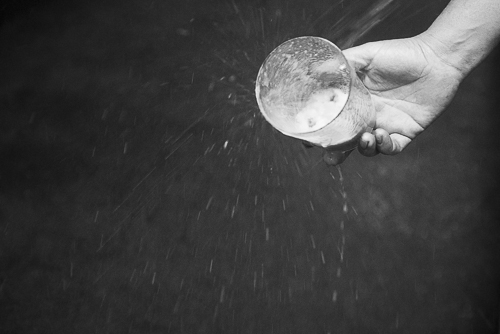Upon arrival, I recognised a local specialty: a rusty iron plate through which the name of the company had been cut. Interestingly, the plate was also shaped like the profile of an apple.
We were met by a young man called Aritz, who together with his father, are running this company. The Oiharte family lives in a restored eighteenth century farmhouse and they have built the cider house next to their house. Using an excavator, they have dug out a large volume, built the cider house and refilled with soil and planted grass such that it looks to some degree like a part of the landscape.
In autumn, apples are harvested and several small-scale producers bring their apples to this cider house. Besides, the Oiharte family has planted some apple trees on their own property and they plan to plant many more. They use apple varieties like:
- Errezila
- Urtebi txiki
- Urtebi haundi
- Gezamina
- Txakala
When the apples arrive, they are placed on the top of a platform. Next, it is filled with water and the apples are forced to flow down to the cider house directly below the platform.
The following workflow has been taken from this site, but it is considered to applicable to cider production in general:
Harvest acidic, bitter and sweet apples: Classify the characteristics of the apples varieties. Depending on the product to be made and the characteristics of the various apple types, more of one variety of apple may be harvested in order to obtain the desired mixture of apples.
- Pre-washing – removing any dust or mud.
- Washing – this is not applicable to organic apples
- Selection – spread out the apples on a table and remove any which has been damaged during transport or are overripe
- Crushing – crush the apples to extract must
- Pressing – apply low pressure to the apples such that the pips are not crushed.
- Must – apple juice analysis. Add must from a different variety of apples if necessary.
- Cooling – cool the must in order to defer fermentation
- Decanting – separation of solids from the must by letting them settle. Remove the residues.
- Fermentation – transforming the must into alcoholic cider by means of yeast, which may be yeast already present on the skin of the apples or add a pure yeast culture.
- Bottling – fill all piping with nitrogen to make it inert and avoid oxidation before the cider is bottled.
Regarding fermentation at this cider house, it is divided into two stages where the first one is as described above. After about 2 weeks, a second fermentation, called malolactic fermentation starts. where malic acid is turned into lactic acid by means of a certain strain of bacteria.
Malic acid contributes to the sourness of green apples and malolactic fermentation tends to create a rounder, fuller mouthfeel.
As regards apple juice, after decanting the must is pasteurised, cooled, and bottled.
After first having entered their restaurant, where they serve meals daily with space for up 100 guests, we entered the cider house where we could see huge tanks storing their products, while nothing interesting was happening due to our arrival some months before harvesting time.
However, being a good cider maker, Aritz showed us how he fills glasses with cider. First, he holds a glass in his hand as far away from his other hand as possible. Then, he opens a tap and cider is flowing out at great speed, filling the glass. Lastly, he let us taste his delicious cider.
Besides apple juice and apple cider, sparkling wine is also produced at this cider house by means of a third fermentation following the champagnoise method. This fermentation will create even more carbon dioxide inside the bottle, leading to an internal pressure of a few atmospheres.
Finally, Aritz showed us a rack containing sparkling wine bottles which were facing partly downwards. They have to be turned regularly in order to let residues settle. When the settling is finished, the necks of the bottles are frozen and the residues are removed. Next, the bottles are refilled, a cork is inserted and a wire is used to prevent the cork from popping out.
This cider house was founded 6 years ago, but the family of Aritz has been making cider for many years for private use. Lots of tourists arrive at Christmas and Easter, likewise during a recent marathon run.
Actually, apple cider is a drink, which has very long traditions in the Basque country since Basque sailors went to the banks near Newfoundland in Canada in order to catch cod and whale. Since water would be contaminated shortly after leaving land, apple cider was used instead and large amounts of apple cider was produced in the Basque country from the 1600s onwards.

